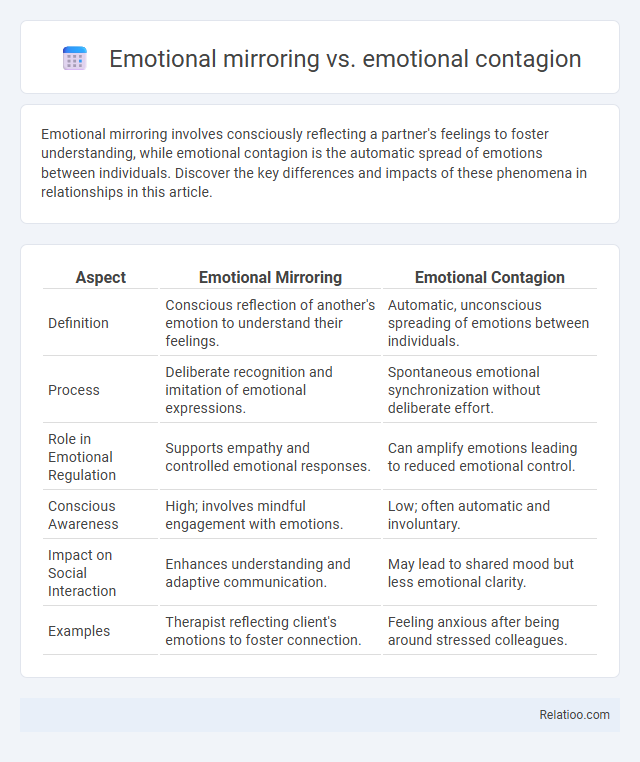Emotional mirroring involves consciously reflecting a partner's feelings to foster understanding, while emotional contagion is the automatic spread of emotions between individuals. Discover the key differences and impacts of these phenomena in relationships in this article.
Table of Comparison
| Aspect | Emotional Mirroring | Emotional Contagion |
|---|---|---|
| Definition | Conscious reflection of another's emotion to understand their feelings. | Automatic, unconscious spreading of emotions between individuals. |
| Process | Deliberate recognition and imitation of emotional expressions. | Spontaneous emotional synchronization without deliberate effort. |
| Role in Emotional Regulation | Supports empathy and controlled emotional responses. | Can amplify emotions leading to reduced emotional control. |
| Conscious Awareness | High; involves mindful engagement with emotions. | Low; often automatic and involuntary. |
| Impact on Social Interaction | Enhances understanding and adaptive communication. | May lead to shared mood but less emotional clarity. |
| Examples | Therapist reflecting client's emotions to foster connection. | Feeling anxious after being around stressed colleagues. |
Introduction to Emotional Mirroring vs Emotional Contagion
Emotional mirroring involves consciously reflecting another person's emotions through facial expressions, body language, and vocal tone to build empathy and enhance social connection. Emotional contagion, by contrast, is the automatic and unconscious process where one person's emotions trigger similar emotions in others, often spreading mood within groups. Understanding the distinction between emotional mirroring and emotional contagion is crucial for effectively managing interpersonal communication and emotional intelligence.
Defining Emotional Mirroring
Emotional mirroring refers to the subconscious process where you reflect another person's emotions through facial expressions, body language, or tone, fostering empathy and connection. Unlike emotional contagion, which involves automatically catching and experiencing someone else's emotional state, emotional mirroring is more intentional and helps regulate interpersonal interactions. Understanding emotional mirroring enhances your ability to build rapport and improve communication in social or professional settings.
Understanding Emotional Contagion
Emotional contagion refers to the automatic and unconscious spread of emotions between individuals through facial expressions, vocal tones, and body language, leading to shared emotional experiences. Unlike emotional mirroring, which involves a conscious reflection of another person's feelings often used in empathy and therapy, emotional contagion occurs instinctively and can influence group dynamics and social interactions. Understanding emotional contagion is crucial for managing interpersonal relationships and enhancing emotional intelligence by recognizing how moods and emotions can transfer within social environments.
Key Differences Between Emotional Mirroring and Emotional Contagion
Emotional mirroring involves consciously reflecting another person's emotions through facial expressions or body language, enhancing empathy and social connection, while emotional contagion is the automatic, unconscious spread of emotions within a group. Key differences include intentionality, with mirroring being a deliberate social behavior, whereas contagion occurs involuntarily through neural and psychological processes. Emotional mirroring requires cognitive engagement and awareness, contrasting with emotional contagion's rapid, instinctive transmission of feelings.
Psychological Mechanisms Behind Emotional Mirroring
Emotional mirroring involves the unconscious imitation of another person's emotional expressions and gestures, activating mirror neurons that enable empathy and social bonding. Emotional contagion is the automatic spread of emotions through social interactions without conscious awareness, often influencing group dynamics and mood regulation. Understanding the psychological mechanisms behind emotional mirroring helps you enhance emotional intelligence by recognizing how shared emotional experiences shape interpersonal connections.
How Emotional Contagion Spreads in Social Settings
Emotional contagion spreads in social settings through the automatic mimicry and synchronization of expressions, vocalizations, postures, and movements among individuals, leading to shared emotional experiences. Unlike emotional mirroring, which involves empathetic understanding and perspective-taking to reflect another's feelings, emotional contagion operates subconsciously and rapidly, influencing group dynamics and collective mood. This phenomenon is amplified in close-knit groups and digital communication platforms where emotional signals are easily transmitted and reinforced.
The Role of Empathy in Emotional Mirroring
Emotional mirroring involves the unconscious replication of another person's emotional expressions and behaviors, serving as a foundational mechanism for empathy by allowing individuals to internally experience others' feelings. Emotional contagion occurs when emotions spread directly from one person to another without cognitive processing, often leading to shared emotional states but lacking deeper empathetic understanding. Empathy's role in emotional mirroring is crucial, as it enables individuals to recognize, validate, and respond to others' emotions with sensitivity, fostering social bonding and effective interpersonal communication.
Impacts of Emotional Contagion on Group Dynamics
Emotional contagion significantly influences group dynamics by synchronizing members' emotions, enhancing cohesion, and amplifying collective moods. Your ability to recognize and manage emotional contagion can improve communication, collaboration, and overall group performance. Unlike emotional mirroring, which involves deliberate empathy, emotional contagion operates involuntarily, spreading feelings rapidly throughout the group and affecting decision-making processes.
Managing Emotional Responses: Awareness and Regulation
Emotional mirroring involves consciously recognizing and reflecting another person's emotions to build empathy and maintain emotional balance, whereas emotional contagion refers to the automatic, often unconscious transmission of feelings that can influence group dynamics and individual mood regulation. Managing emotional responses requires heightened self-awareness to distinguish between these processes, enabling intentional regulation rather than reactive emotional shifts. Developing strategies such as mindfulness and cognitive reframing enhances the ability to control emotional contagion while leveraging emotional mirroring for constructive interpersonal communication.
Practical Applications in Relationships and Communication
Emotional mirroring helps You build trust and deepen connections by reflecting your partner's feelings accurately, fostering empathy and understanding in relationships. Emotional contagion can intensify shared emotions, sometimes causing mood swings or misunderstandings, so managing it is crucial for effective communication. Emotional regulation is essential to balance these processes, enabling clearer conversations and healthier emotional exchanges with your loved ones.

Infographic: Emotional mirroring vs Emotional contagion
 relatioo.com
relatioo.com